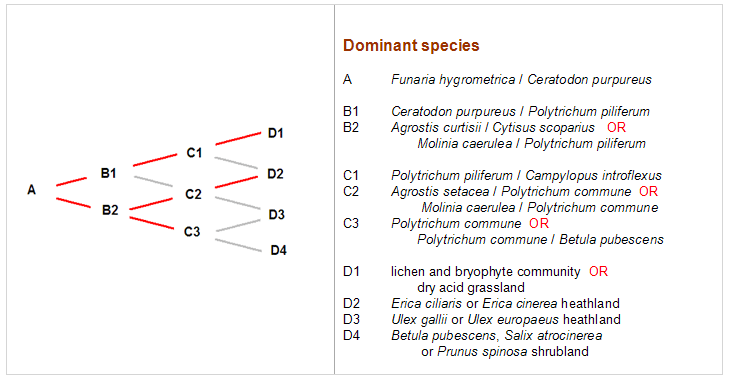Case StudiesOpportunities after fireWhile fire is destructive it also provides opportunities for various bryophytes. These opportunities may be short-term or long-term. A moss such as Funaria hygrometrica benefits in the short term. Fire removes competition allowing Funaria to thrive, but after perhaps a year two other mosses become dominant. The example of Cephaloziella exiliflora shows another case of post-fire benefit, often longer-lasting than the benefit to Funaria on soil. While Cephaloziella is also found on soil and growing amongst other bryophytes, charred wood allows it to grow in profusion, in extensive colonies by itself. It can be found carpetting charred logs even years after a fire. Fires may also bring about extensive and long-term changes in bryophyte populations. In 1976 severe fires destroyed large areas of heathland in Brittany, France. In a paper, published in 1990, that reported on 12 years of post-fire study of these areas, the authors reported three common plant succession routes, involving up to four stages. The first stage, marked as A in the following diagram, is a community dominated by Funaria hygrometrica and Ceratodon purpureus. From A the succession goes to the right, the red lines marking the main successional pathways, the grey lines indicating infrequent pathways. After about 3 or 4 years the B plant communities have developed and their dominant species are listed below. The plant communities at the C stage become dominant 8 or 9 years after fire. By the 12th year after fire the D communities had developed to some degree. The bryophytes (all mosses) are given in bold in the community descriptions. The other listed species are vascular plants, Agrostis and Molinia being grasses, the others being shrubs or small trees. Where a community description lists two species, separated by a slash, the first species has a relative frequency of at least 50% and the second has one within the range of 10-30%.
Which of the B, C or D communities develops depends on local factors. For example D1 is a community of highly stressed areas. D4 can develop in the more fertile areas, provided the moss layer of the C2 or C3 communities has been disturbed sufficiently. The diagram shows the three common routes through these communities :
Bryophytes, in particular the genus Polytrichum, are major components of many of the plant communities. Of these three routes, only the one finishing with D2 produces a heathland community resembling the pre-fire vegetation. In the route ending with D1 the final stage is either a lichen and bryophyte community or a grassland which would provide micro-habitats for various bryophytes. Given that grasses were not dominant in the pre-fire heaths, the new micro-habitats may well provide greater potential for species not previously in the heathlands or which were previously more restricted. Thus there is potential for a long-term change in the relativities between the bryophyte species. The gametophytes of Polytrichum commune had grown to heights of 30 to 80 centimetres after a few years and were often growing densely. Such dense Polytrichum colonies greatly inhibited the growth of vascular plants. The authors noted that in plant communities, such as C3, that are dominated by Polytrichum commune succession usually seems to halt there and that state is likely to persist for several decades. The authors also estimated that plant mass in such Polytrichum communities was between 48 and 72 tonnes per hectare, which compared well with the estimates of at least 50-60 tonnes per hectare for the pre-fire heathland. Fires of similar severity had burnt about 600 hectares of moorland in Yorkshire, England in 1976. The pre-fire vegetation had been dominated by the heath genus Calluna. By 1984 only about 6% of the area was covered by vascular plants, with under 2% comprising Calluna-dominated vegetation. Bryophyte-dominated communities (with Polytrichum a major component) covered about 65% of the area and the remainder was predominantly bare. In summary, the aftermath of the Brittany and Yorkshire fires has seen significant and long-lasting changes in bryophyte populations. In this regard bryophytes are no different to vascular plants. It is well-known that major disturbances (such as those caused by severe fires) can cause significant changes in vascular plant communities and that such changes can last for many decades, centuries or even millennia.
|
![An Australian Government Initiative [logo]](/images/austgovt_brown_90px.gif)


